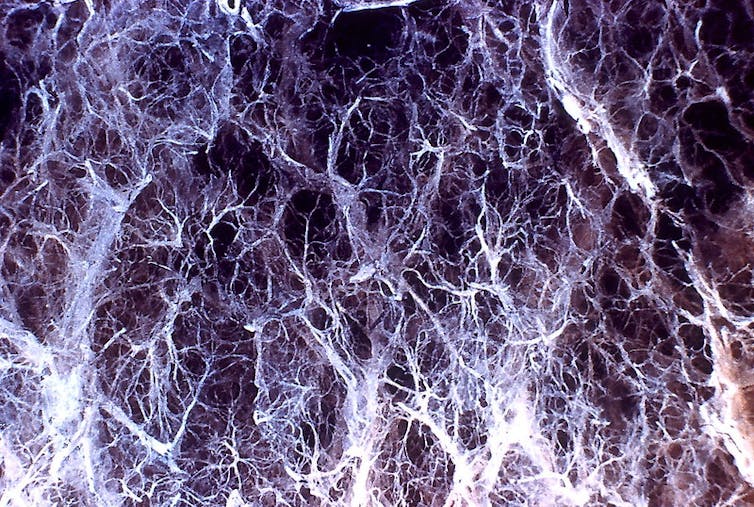2022-08-01 マサチューセッツ大学アマースト校

Lung damage from alpha-1 antitrypsin deficiency can lead to emphysema. Atlas of Pulmonary Pathology/Flickr, CC BY-SA
アデノ随伴ウイルスの無害化したものを、AAT遺伝子治療を注射で体内に導入する手段として使用し、数年にわたりタンパク質を持続的に放出させる方法を開発したのです。
チームは、遺伝子治療から1〜5年後のAAT濃度は、治療効果に最適な濃度の2〜2.5%に過ぎないことを発見した。
マウスの筋肉細胞にさまざまな分子を作用させ、AATの分泌を促進させるかどうかを調べました。結果、スベロイルアニリドヒドロキサム酸(SAHA)と呼ばれる分子を添加すると、筋肉細胞が肝細胞のような生産レベルでAATを作るのを助けることがわかりました。SAHAがプロテオスタシスの調節因子であり、細胞のタンパク質の産生を高める働きがあるためです。
<関連情報>
- https://theconversation.com/helping-cells-become-better-protein-factories-could-improve-gene-therapies-and-other-treatments-a-new-technique-shows-how-187515
- https://www.pnas.org/doi/abs/10.1073/pnas.2206103119
機能性α1-アンチトリプシンの分泌は細胞タイプに依存する。遺伝子治療のための筋肉内投与への影響 Secretion of functional α1-antitrypsin is cell type dependent: Implications for intramuscular delivery for gene therapy
Haiping Ke, Kevin P. Guay , Terence R. Flotte, Lila M. Gierasch , Anne Gershenson and Daniel N. Hebert
Proseeding of the National Academy of Sciences Published:July 28, 2022
DOI:https://doi.org/10.1073/pnas.2206103119
Significance
Protein expression in nonnative cell types is critical for successful gene therapy. Here, we explore the expression of α1-antrypsin (AAT), a gene therapy target, in a variety of cell types and assess the ability of chemical methods to boost its expression. While AAT was efficiently secreted by hepatocytes, its native host, it was poorly expressed in myoblasts and myotubes, although its secretion could be augmented by treatment with the proteostasis regulator suberoylanilide hydroxamic acid, a histone deacetylase inhibitor. The use of proteostasis regulators thus provides a potential strategy to optimize protein expression for a variety of therapeutics.
Abstract
Heterologous expression of proteins is used widely for the biosynthesis of biologics, many of which are secreted from cells. In addition, gene therapy and messenger RNA (mRNA) vaccines frequently direct the expression of secretory proteins to nonnative host cells. Consequently, it is crucial to understand the maturation and trafficking of proteins in a range of host cells including muscle cells, a popular therapeutic target due to the ease of accessibility by intramuscular injection. Here, we analyzed the production efficiency for α1-antitrypsin (AAT) in Chinese hamster ovary cells, commonly used for biotherapeutic production, and myoblasts (embryonic progenitor cells of muscle cells) and compared it to the production in the major natural cells, liver hepatocytes. AAT is a target protein for gene therapy to address pathologies associated with insufficiencies in native AAT activity or production. AAT secretion and maturation were most efficient in hepatocytes. Myoblasts were the poorest of the cell types tested; however, secretion of active AAT was significantly augmented in myoblasts by treatment with the proteostasis regulator suberoylanilide hydroxamic acid, a histone deacetylase inhibitor. These findings were extended and validated in myotubes (mature muscle cells) where AAT was transduced using an adeno-associated viral capsid transduction method used in gene therapy clinical trials. Overall, our study sheds light on a possible mechanism to enhance the efficacy of gene therapy approaches for AAT and, moreover, may have implications for the production of proteins from mRNA vaccines, which rely on the expression of viral glycoproteins in nonnative host cells upon intramuscular injection.


